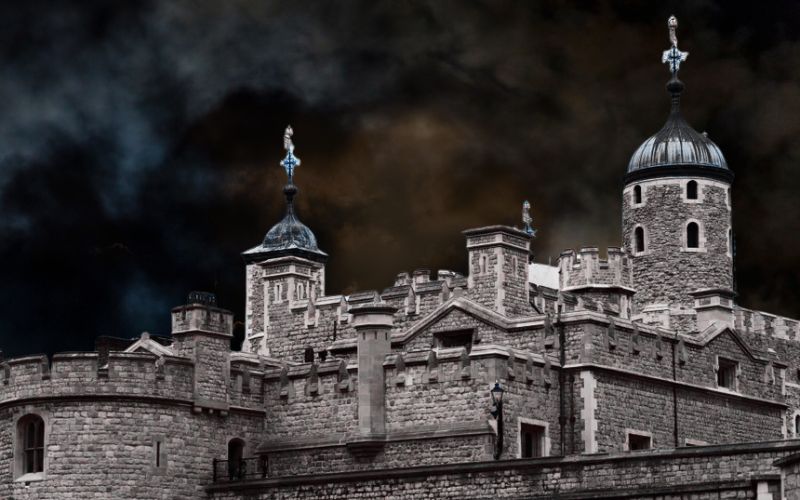The Tower of London is one of England’s most iconic–and most haunted landmarks in history. Steeped with over 900 years of dark history, the Tower has witnessed some of the most infamous betrayals, executions, and ghostly occurrences in British history. From royal prisoners to headless apparitions, this fortress has long been a place where the past refuses to rest. So, let’s unlock the Tower’s gates and take a journey through the eerie events that still haunt its halls today.
A Dark History: The Origins of the Tower
The Tower of London was constructed in 1078 by William the Conqueror as a symbol of Norman power, and over the centuries, it evolved into a royal palace, prison, and place of executions. As the backdrop for political intrigue, treachery, and rebellion, the Tower became the final stop for many ill-fated prisoners, earning its reputation as a place filled with doom and dread.
Perhaps the most notorious part of the Tower’s history is its role as a site of gruesome executions. Prisoners of the crown—ranging from noble families to political dissenters—were often brought to the Tower to face their final days, and many met their death on the Tower Green, just steps away from the White Tower. Among these victims were some of England’s most famous figures, whose ghostly presences are said to still linger.
The Ghosts of the Tower: Legends of Hauntings
With its bloody history, the Tower of London has become one of the most haunted locations in the world. Numerous spectral sightings and unexplained phenomena have been reported over the years, giving the Tower its fearsome reputation as a paranormal hotspot. Here are some of the most spine-tingling ghost stories associated with this historic fortress:
Anne Boleyn: The Headless Queen
Perhaps the most famous ghost to haunt the Tower is Anne Boleyn, the ill-fated second wife of Henry VIII. Accused of treason and adultery, Anne was executed on May 19, 1536 within the Tower grounds. Legend has it that her headless ghost has been seen wandering the Tower Green and the Chapel of St. Peter ad Vincula, where her body is buried.
Witnesses claim to have seen her carrying her severed head in her hands, a chilling reminder of her tragic demise. Some have even reported hearing the faint whispers of her final prayers near the site of her execution. The sorrowful energy surrounding her story continues to haunt those who visit the Tower today.
The Princes in the Tower
The tragic tale of the Princes in the Tower is one of the Tower’s darkest mysteries. In 1483, Edward V and his younger brother Richard, Duke of York, were imprisoned in the Tower by their uncle, Richard III, after the death of their father, Edward IV. The boys were never seen again and are believed to have been murdered to secure Richard’s claim to the throne.
Since their disappearance, many visitors to the Tower have reported seeing the ghosts of two young boys dressed in period clothing, wandering the dark corridors and staircases. Their pale, forlorn figures are said to appear, silently holding hands, before vanishing into the shadows. The story of the princes has fascinated and haunted historians for centuries, adding a deep sense of melancholy to the Tower’s already grim history.
The White Lady of the White Tower
Another ghostly figure that has been frequently reported is the White Lady, who is said to haunt the White Tower, the oldest part of the fortress. She has been seen standing near the north battlements, often staring out toward the River Thames. Visitors who pass through the area sometimes report an overwhelming sense of sadness and despair, as though they are being watched by unseen eyes.
One of the most chilling aspects of the White Lady’s haunting is the overpowering smell of strong perfume that accompanies her presence. It is said that the scent of her perfume is so intense that it can make those who encounter it feel faint or dizzy.
Dark Rituals: The Supernatural and the Tower Ravens
The Tower of London is not only home to ghostly figures but also to ancient traditions of a superstitious nature. One of the most famous traditions involves the Tower ravens. According to legend, the presence of the ravens is crucial to the survival of the Tower and, by extension, the British monarchy. The saying goes, “If the ravens leave the Tower, the kingdom will fall.”
These black birds are considered guardians of the Tower, and their wings have been clipped to ensure they never fly away. Despite the precaution, some visitors have reported seeing ravens behaving strangely near the execution sites, as if disturbed by the lingering spirits that haunt the grounds. In some eerie tales, visitors claim to have seen the birds gather in large groups, staring at seemingly empty spots in the Tower, watching something that cannot be seen by human eyes.
The Tower’s Torture Chambers: Echoes of Agony
Beyond ghostly sightings, the Tower of London also holds a long, dark history of torture. Many prisoners—both political and criminal—were subjected to brutal interrogations in the Tower’s infamous torture chambers. Devices like the rack, the Scavenger’s Daughter, and the manacles were used to extract confessions, often leaving victims permanently maimed or dead.
Today, visitors to these grim chambers report hearing phantom cries of agony and the sounds of chains rattling, even when the rooms are empty. Some have even felt cold, ghostly hands brushing against their skin as they explore the dimly lit spaces where prisoners once suffered.
The Tower of London’s long and brutal history of betrayal, bloodshed, and imprisonment makes it a symbol of dark power and paranormal intrigue. Its towering walls have witnessed the fall of queens, the murder of innocents, and the suffering of countless prisoners. As a result, the Tower has become a location for supernatural energy, with spirits from all eras of British history believed to be trapped within its stone walls.
The eerie tales of headless queens, haunting princes, and spectral figures wandering the grounds serve as a chilling reminder of the price of power and the ghosts it leaves behind. The Tower of London is not only one of England’s most famous landmarks—it’s a place where the past still lingers forever in its haunted halls.
As I wrap up this week’s journey on Bell’s Books and Blog, thank you for joining me on this eerie adventure! If you enjoyed the read, don’t forget to sign up for my weekly newsletter at books.janembell.com. As a special thank-you, you’ll receive a free digital copy of Yesteryear’s Ruin, the prequel to my latest novel, Yesteryear’s Echo. Just click on the Yesteryear’s Ruin book cover!
For more haunted histories, tune in to this week’s Bell’s Books and Blog Podcast, where I take you to other spooky sites like Salem, Massachusetts, and the Winchester Mystery House—each location teeming with its own ghostly legends and shadows from the past.
You can catch the latest podcast episode on my podcast page or find links to your favorite platforms like Amazon Music, Audible, Apple Podcasts, Spotify, and more. Be sure to subscribe wherever you listen, so you don’t miss an episode!
Until next time—stay curious, keep questioning, keep exploring, keep reading and, of course, keep the past alive!
Wishing you a hauntingly delightful Halloween!





 “Yesteryear’s Ruin” captures the essence of human resilience in the face of unimaginable loss. Through a narrative that weaves together love, despair, and the quest for redemption, this historical psychological thriller invites readers into a world where the past is not merely a memory, but a realm that may hold the key to our deepest desires and darkest fears.
“Yesteryear’s Ruin” captures the essence of human resilience in the face of unimaginable loss. Through a narrative that weaves together love, despair, and the quest for redemption, this historical psychological thriller invites readers into a world where the past is not merely a memory, but a realm that may hold the key to our deepest desires and darkest fears.